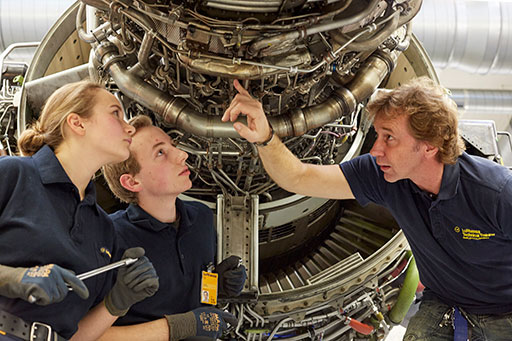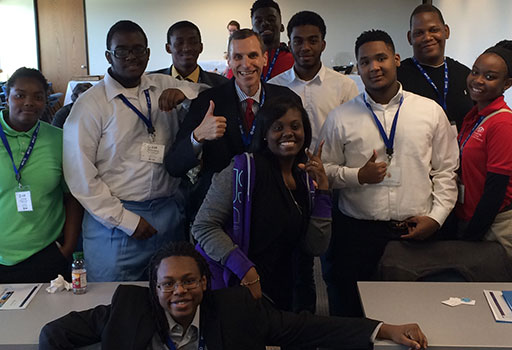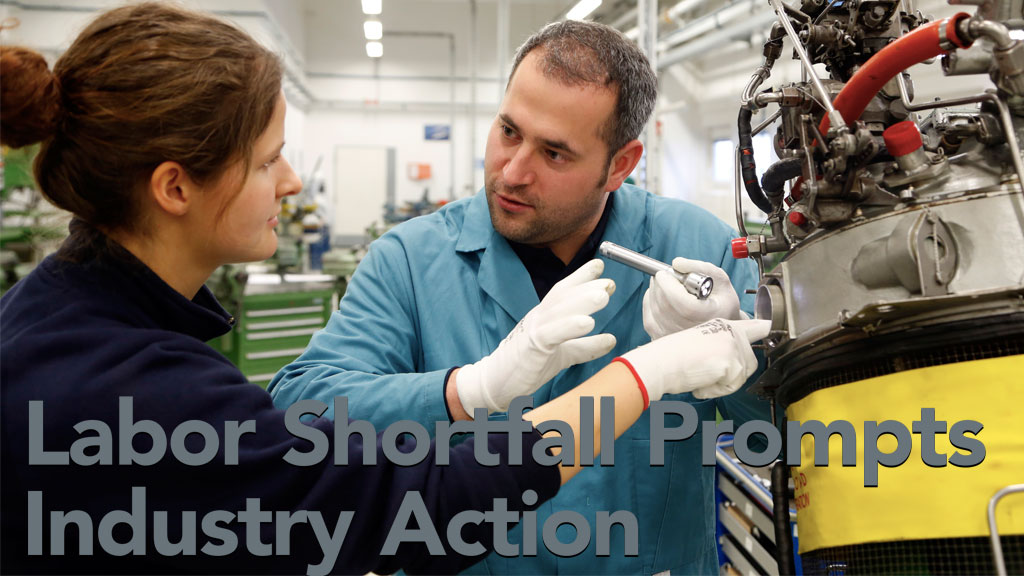The impending dearth in skilled maintainers is triggering the industry to increase its profile and work with education establishments to re-position aviation engineering and technical skills as an attractive career option.
It’s tough times for aviation maintenance employers. Demand is high for graduates of aviation maintenance schools, particularly specialists like avionics technicians and sheet metal mechanics, and even for beginners who can be trained on the job. Employers are reaching out to middle schools, high schools, and colleges to boost interest in maintenance careers while beefing up internal training programs.
Adding to the challenge are more fundamental questions, in the United States (U.S.) at least, about what students at aviation maintenance schools are learning and how adaptable the curriculum is to what industry actually needs. Stay tuned for a revision of 14 CFR 147 (Part 147), which governs aviation maintenance technician (AMT) schools.
Supply and Demand
According to an Oliver Wyman study, by 2027 the demand for aviation mechanics in the U.S. could outstrip supply by nine percent. The firm expects aviation maintenance technician retirements to spike in the next decade, given that the median age of aviation mechanics is 51, almost a decade older than the average worker. The problem would bite when the world fleet is expanding and modernizing.
The situation is “probably worse on the [employer] end than what you see in a lot of the statistics,” said John Gallagher, HR manager with Component Repair Technologies (CRT), a Mentor, Ohio, specialist in the repair of large metal engine components.
The problem is “a serious threat to the growth of companies that rely on skilled labor that requires specialized training or industry certifications but not necessarily a four-year bachelor’s degree,” echoed Greg Dellinger, director of talent acquisition for AAR.
Unfilled positions may be costing U.S. repair stations as much as $1.95 billion in lost revenues this year, according to the Aeronautical Repair Station Association. Various assumptions are involved in coming up with that figure, but there is definitely more money to be made.
Lufthansa Technical Training (LTT), an arm of Lufthansa Technik (LHT), sees the looming shortage of AMTs as mainly a demographic issue – the convergence of trends such as the aging workforce and the focus on white-collar jobs. The problem is serious, especially with groups such as ‘highly licensed mechanics,’ and the shortfall will occur sooner rather than later, said Georg Walter, LTT’s head of product management and marketing in Frankfurt.

Supply & Demand
Crystal Maguire, executive director of the Aviation Technician Education Council (ATEC) stated that U.S. aviation maintenance schools are placing around 90 percent of their students upon graduation. ATEC represents 120 of the 170 certificated schools in the FAA database.
Embry-Riddle Aeronautical University’s maintenance program enjoys an official placement rate of 98 percent,” according to Assoc. Prof. Charles Horning, chairman of Embry-Riddle’s Aviation Maintenance Science Department. For the last several years it’s basically been 100 percent, he confirmed.

Embry-Riddle is seeing employers “getting more pro-active about trying to partner with schools,” he said. It has internships with Delta Air Lines, for example, that involve students in line maintenance. Horning has also seen increasing interest in the last two or three years from business aviation.
One of the problems is the pipeline. Only 60 percent of students coming out of aviation maintenance schools take the FAA certification test, said Maguire. According to an ATEC survey, one out of four graduates chooses another field. Since AMT skills are highly transferable, graduates are sought after by other industries, such as amusement parks and oil & gas, which may offer higher hourly rates, she suggested.
Root Causes
Dellinger said that the problem dates back to “lackluster investment in vocational education following de-industrialization in the 1980s. Enrollment in A&P [airframe & powerplant] licensing programs plummeted after 9/11 and has yet to return to pre-9/11 levels … Until public policy catches up, employers will be required to make the investment in training workers they need now and in the future.”
Shortages are most acute with FAA-certified A&Ps; U.S. Federal Communications Commission-certified avionics technicians specializing in radios, navigation equipment, and computers; structural technicians; and sheet metal mechanics, according to AAR.
What’s to be Done?
CRT takes an aggressive, “all hands on deck” approach to recruiting talent, extending from partnerships with schools and colleges to robot competitions and powwows with local principals and guidance counselors, but especially emphasizing internal training. These activities can be a little daunting on top of running the business, but it’s an “investment in the long term,” explained Gallagher.
High schools are “trying to get the correct career paths” for their students, he said. After years of steering all the students toward four-year college degrees, “they are now realizing this was probably not the best approach… and are trying to figure it out.”
CRT works with neighboring Lakeland and Cuyahoga community colleges. The company has a machinist apprenticeship program with Cuyahoga. And CRT representatives sit on Lakeland’s welding, machining, and engineering advisory boards. The company also donated scrap parts and weld wire to Lakeland. As a result, when students complete the school’s welding class, they are already experienced with the nickel metal alloys that CRT uses.
CRT, however, devotes most of its workforce development resources to enhancing its internal training programs. It works with online content providers such as Tooling U and BizLibrary. Beyond that Component Repair Technologies has developed “hundreds of … online courses,” said Gallagher. It is currently developing “a pretty lengthy computer-based training module to teach how to mask parts.”
Dellinger said that AAR is also creating a “talent pipeline” through partnerships in communities near each of the company’s five aircraft maintenance centers in North America. One of the main reasons the company built a facility at the Rockford airport in Rockford, Ill., was an agreement that Rock Valley College would enhance its training program. The community college has built a 40,000-square-foot training center at the airport to train more A&Ps, and the program is now “completely full, with 170 students.”
AAR’s facility in Oklahoma City has partnered with the Francis Tuttle Technology Center to design a sheet metal technician apprenticeship and training program that combines classroom and on-the-job training (OJT).
In Indianapolis AAR has a long-standing relationship with Vincennes University. “We have trained sheet metal technicians using the Structures Technician registered apprenticeship training curriculum that AAR developed with Francis Tuttle, and we hire 20 percent of Vincennes’ A&P licensed graduates right off the top,” declared Dellinger.
LTT has been offering apprenticeships for more than 60 years. The LHT unit gives high marks to the dual system of vocational training that combines company OJT with instruction at a technical college or training center in Germany, Austria, and Switzerland. Nevertheless “it has become more and more difficult to fill apprenticeship vacancies,” admitted Walter. LTT also is targeting students who are not finishing their university degrees.
LTT combines the latest learning techniques with the tried-and-true. It “brings aircraft into the classroom via visualization, e.g., spherical panoramas,” added Walter. But it also has “training aircraft on-site in Hamburg and Frankfurt.”
New Categories
“To accelerate hiring of entry-level workers,” AAR has created the support technician job category of “non-technical workers [who can] perform basic skills labor under the tutelage of a licensed A&P mechanic,” said Dellinger. After 18 months of training, these individuals “are better equipped to pass the test to become airframe-certified.”
AAR and other MROs have been involved in an effort with Francis Tuttle and the National Center for Aerospace & Transportation Technologies in Ft. Worth, Texas, to establish a portable, nationally recognized credential for airframe sheet metal technicians.
Duncan Aviation conducts outreach, as well. The company works with the Bakers School of Aeronautics to help employees achieve their A&P license while working full-time. In addition Duncan Aviation routinely offers summer internship programs for students in aviation-related fields, said Felicia Nichelson, manager, professional development, training, and safety. Approximately 15 internships are available across the company’s three main locations.
Curricula Realignment
Curriculum requirements for FAA-certificated schools have changed little in decades. The disconnect between the FAA requirements and market needs has powered a drive to revise Part 147, which regulates AMT/A&P schools and what they teach, as well as Part 65, which includes test standards. Still aspirational at this point, is the effort to align curricula with testing requirements, so that students are taught what industry expects them to know.
AAR agrees that the FAA Part 147 curriculum needs updating. An A&P license is essentially “a license to learn,” Dellinger said. “FAA curriculum standards for A&P mechanics apply decades-old technologies.”
The new Part 147 could roll out this year. And a new standard for A&P testing may arrive next year. Currently in draft form, the new document, known as the Aviation Maintenance Technician Airman Certification Standards, or ACS, revises A&P testing procedures and could ultimately bear on curriculum management. ACS describes the minimum level of knowledge and skills that an A&P requires, said Maguire. The new document also expands the scope of practical testing to include risk management.
Outdated Rule
Part 147 “is way overdue for a revisit,” according to Maguire. She expects that the very specific curriculum requirements now in the rule will be taken out, so that the rule will be more focused on the requirements that schools must meet in areas such as facilities and equipment.
Part 147 also gets into grading standards. Because local FAA inspectors are not necessarily experts in this area, “nightmare situations” can arise, where a school may have to change an institution-wide grading system “because of the whim of the local inspector.” Maguire hopes that the Part 147 regulations on grading standards and A&P testing norms are removed in the rewrite or through the process supporting larger, “two for one” regulation reform.
One Step Further?
“We also asked the agency to go one step further … to set knowledge and skill standards through the mechanic tests and let schools teach to these standards,” Maguire said.
“Ideally we would like to use the ACS to drive school curriculum, which makes sense because the ACS is going to define the testing standards – what the applicants are going to be tested on to get the A&P certification,” said Horning. “That basically tells schools what they need to be teaching in the curriculum.” Updating subject matter through the schools’ operations specifications (ops specs) which would, in theory, reference the current ACS, would be much faster than trying to change the regulations.
FAA may or may not sign off on the idea of using ACS to drive curriculum updates without changing Part 65, Horning cautioned. A rule change process can take five to six years to complete.
But even if the hoped-for alignment of curriculum with testing standards doesn’t pan out in the near future, ACS will be a “big improvement,” if only because it ties the items being tested to FAA guidance material, he said. The ACS activity also has established a review board to evaluate test questions and verify that they can be tied back to ACS and supporting guidance.
